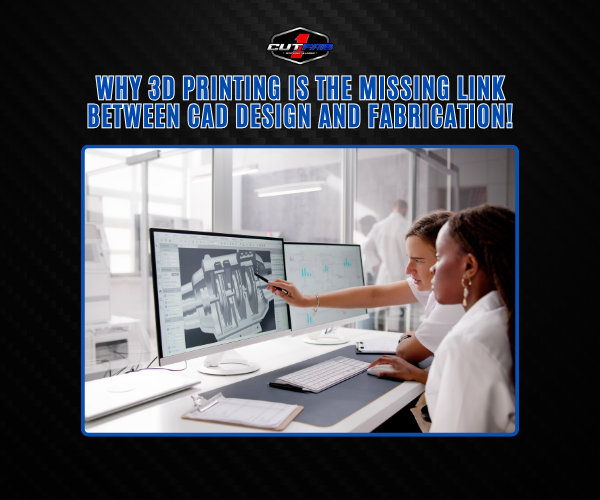
Why 3D Printing is the Missing Link Between CAD Design and Fabrication!
In the world of modern manufacturing, the journey from a digital concept to a tangible product often hits a critical snag—the prototype gap. Engineers and designers can create flawless models in CAD software, but translating those virtual designs into physical prototypes has long been a slow, costly, and error-prone process. This disconnect between design and fabrication can derail timelines, inflate budgets, and compromise innovation.
This is where 3D printing between CAD design and fabrication becomes a game-changer.
By acting as the seamless bridge between digital modeling and real-world production, 3D printing eliminates many of the traditional bottlenecks. It enables rapid prototyping directly from CAD files, drastically reducing the need for complex tooling or machining at the early stages. More importantly, it allows iterative design testing—what you see on-screen is now what you get in your hands, often within hours.
In this blog, we’ll dive into how 3D printing is revolutionizing this crucial link—and why it's reshaping the future of manufacturing.
How 3D Printing Bridges Concept and Production
When it comes to turning a concept into a functional product, speed and accuracy are everything. Traditional manufacturing often struggles to keep up with the rapid pace of design iteration. That's where 3D printing between CAD design and fabrication offers a revolutionary advantage—by cutting out the middlemen, shortening production cycles, and enabling agile development.
Quick Turnarounds
One of the biggest advantages of 3D printing is the ability to produce prototypes and even final-use parts within hours, not weeks. Once a CAD file is finalized, it can be sent directly to a 3D printer without the need for custom tooling or lengthy setup. This dramatically accelerates product development timelines and allows teams to move from design to physical prototype in a single day. It’s not just faster—it’s smarter.
Design Validation and Revisions
3D printing empowers designers to test real-world versions of their digital models early and often. Want to tweak a curve, reinforce a joint, or test a new texture? No problem. With additive manufacturing, revisions are as simple as updating the CAD file and hitting "print." This instant feedback loop ensures that by the time a design reaches the fabrication stage, it's been validated, optimized, and refined—saving time, money, and frustration.
In essence, 3D printing bridges the gap between CAD design and fabrication by transforming static plans into tangible prototypes with unprecedented speed and flexibility. It’s the link every modern product team needs to stay competitive.
Case Studies: Real-World Use of 3D Printed Prototypes
To truly understand the impact of 3D printing between CAD design and fabrication, it helps to look at how it’s being applied in the real world. Across industries, businesses are using 3D printed prototypes not just for concept validation—but to dramatically improve communication, reduce errors, and speed up approvals. Here are two practical examples that showcase this evolution.
Fitment Testing for Welded Assemblies
In metal fabrication, even a few millimeters of misalignment can ruin a welded assembly. Traditionally, verifying fitment required machining parts or fabricating soft tools—an expensive and time-consuming process. Today, many manufacturers are using 3D printed mock-ups to test alignment before committing to final fabrication.
By printing scaled or full-size versions of the parts from CAD models, fabricators can assemble components, identify potential collision points, and make design tweaks before a single weld is laid. This not only ensures precision but also saves thousands in rework costs.
Mock-Ups for Client Approval
Design firms and manufacturers working with clients—especially in architecture, interior design, or consumer products—are leveraging 3D printed mock-ups to secure approvals faster. Instead of sharing flat renders or complex CAD files, teams present tangible models that clients can touch, hold, and understand instantly.
This approach bridges the communication gap, builds trust, and accelerates project timelines. It’s another powerful example of how 3D printing between CAD design and fabrication doesn’t just improve production—it transforms collaboration.
These case studies show that 3D printing isn’t just about prototyping—it’s a strategic tool that brings digital vision to life with accuracy and speed.
Conclusion: Leveraging 3D Printing to Improve Efficiency and Accuracy
In today’s fast-paced design and manufacturing environment, every second counts—and so does every millimeter. The traditional gap between CAD design and physical fabrication has long been a bottleneck, slowing innovation and increasing the risk of costly errors. But now, 3D printing between CAD design and fabrication is turning that bottleneck into a streamlined highway.
By enabling rapid prototyping, precise fitment testing, and real-time design validation, 3D printing empowers teams to move from idea to execution with unprecedented accuracy. Whether you're testing welded assemblies or presenting a client-ready mock-up, additive manufacturing brings designs to life faster, cheaper, and with fewer surprises.
For businesses that want to stay ahead of the curve, integrating 3D printing into their CAD-to-fabrication workflow isn’t optional—it’s essential. It's not just a tool; it’s the missing link that closes the loop between digital creativity and real-world production. The result? Better products, faster timelines, and a competitive edge that’s hard to beat.
